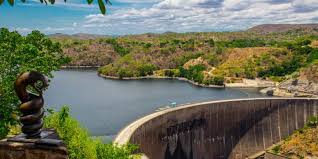-there is likely to be a delayed start to the rainfall season for the whole of Southern Africa due to the presence of El Nino, FEWSNET warned.

John Cassim
Harare, Zimbabwe (CZ) – The Zambezi River Authority (ZRA) has reduced water allocation for hydroelectricity generation this year for Zambia and Zimbabwe, amid growing concerns of an impending El Nino.
ZRA slashed the water allocation from 40 billion cubic meters to 30 billion cubic meters, due to suppressed inflows in Lake Kariba.
The reduction was influenced by a change of the rainfall pattern on the lower Kariba catchment to Normal to Below Normal compared to Normal to Above Normal earlier predicted, for the 2022/23 rainfall season.
ZESCO in Zambia and Zimbabwe Power Company (ZPC) share water from Lake Kariba, for hydro-electricity generation.
The Zambezi River Authority (ZRA) a Bi-National organization mandated to manage the use of water on the Zambezi River for the two countries Zambia and Zimbabwe reduced the allocation to 40 BCM in September 2022 for the power generation in 2023.
The allocation was informed by projections from the Southern Africa Regional Climate Outlook Forum (SARCOF)-26 that was held in August 2022 and further reconfirmed by the downscaled positions of the Metrological.
“Agencies of Zambia and Zimbabwe, both projected that the SADC and Kariba catchment region was to experience Normal to Above Normal for the 2022/23 rainfall season.
“The actual performance of the 2022/23 rainfall season for the lower Kariba catchment, however, turned out to be Normal to Below Normal.”
“Accordingly, through the first quarter hydrological analysis, the Authority reduced the water allocation from 40 BCM to 30 BCM to be shared equally between ZESCO and ZPC at their Kariba Stations,” Munyaradzi Munodawafa, Chief Executive Officer of Zambezi River Authority, said in a statement on Tuesday.
With the 2022/23 rainfall season having effectively ended in April 2023, the Kariba Catchment is no longer experiencing any rainfall activities.
Flows of the Zambezi River and its tributaries are now receding and this downward trend is expected to continue until the commencement of the next rainfall season (2023/2024 rainfall season).
-worst load shedding in Zimbabwe
Owing to the reduced power generation on Lake Kariba, the ZPC was incapacitated resulting in widespread blackouts that lasted between 12 to 18 hours in most cases.
This affected industry and commerce, towards the end of 2022 and early 2023, hence pressure was increased on the government to speed up construction work at Hwange 7 and 8 thermal units.
Hwange Thermal Power Station was built in two stages in the 1970s and started with 4 units of 120 MW each and 2 units of 220 MW each.
Two new units 7 and 8 of 300 MW each, were added and synchronised in the first half of 2023, adding 600 MW to the national grid.
According to the Zimbabwean government construction of the Hwange Units 7 and 8 was delayed by the COVID-19 pandemic.

-El Nino predicted.
Meanwhile, the Southern African region is expected to receive below-average rainfall during the forthcoming 2023/24 rainfall season that kicks off in October, according to the Famine Early Warning Systems Network (FEWSNET) recently.
In a food security outlook for Zimbabwe, FEWSNET said there is likely to be a delayed start to the rainfall season for the whole of Southern Africa due to the presence of El Nino.
El Nino is a weather phenomenon that is associated with low rainfall.
“From October to December 2023, the start of the rainy season is likely to be mixed with a possible delayed start due to El Nino.
However, December to March precipitation, during the height of the wet season, is likely to be below average,” the network said.
This is expected to negatively impact the 2023/24 rainfall season, including agricultural harvests and pastures for livestock, FEWSNET warned.
Water inflows into Lake Kariba are most likely going to be affected thereby further affecting hydro-power generation for both Zambia and Zimbabwe.
